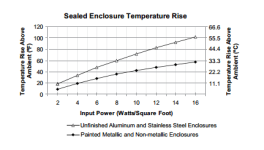It's not really the kind of filter, as the kind of fan. Even muslin is probably too restrictive.Cowardlyduck said:Yes, I agree that a test is needed as coffee filters are normally meant to filter water, not air, so it is likely they may not let much through.
In my experience, "box" fans like those move lots of air when totally unimpeded, but with anything that causes an airflow limitation the partial vacuum behind the blades ends up causing the airflow to stop or nearly stop, and just recirculate around the fan blades.
Sometimes it even puts such a high load on the bearings that the fan overheats and fails.
I never used those particular fans, but I tried quite a few things back in my PC hotrodding days to cool the computers quietly but greatly, without sucking doghair and dust inside (both really big problems here), and fans with filters were my first option. The best filters were actually just large-hole windowscreen mesh, holes more than 1mm in size, on the inside part of an small box inlet that expanded after letting air inside the case thru a small hole. All fans were on the actual outlet, with no grillework or anything to impede airflow or cause turbulence.
I used slower fans, because there was less turbulence around the fan and so less noise and less wasted power (any noise is wasted power, usually from airflow turbulence), and the dust when not sucked in quick would settle on the filter or just before it, from the slowdown in the airflow from the expansion of hte air after coming in thru the smaller hole into the larger chamber.
I don't know that there's space to do all that inside the hubmotor, but if there was, it'd probably be the best way to work it.
If you could put the fans external to the hub, and have a nearly continous wide slot in the cover for the outlet and inlet, and a disc on the bike frame covering each slot as close to the cover as possible, then put the fan in a duct on the fork so it was far enough away from the cover to prevent turbulence at it's backside and the end of the duct was far enough away from the fans to prevent turbulence at it's front side, then you could put the screen (if needed) in the inlet duct, and the fan in hte outlet duct. You could also use a much larger diameter fan, and it'd be able to run slower with less turbulence and less noise and more fan blade/airflow area for the size of the fan (vs motor and frame area),
SOmething sort of similar in concept was used by Lowracer on his trike, but unfortunately his site, photos, and vids are gone and/or don't work anymore, and he hasn't been around in a long time and doesn't respond to contact attempts. There's a little descriptive info in his threads, but not much. IIRC his was super high speed fans ina duct that sucked or blew air thru a tube from next to the hub on a series of holes.
IN the PC's eventually I went to single slow-rotating but very large diameter fan with ducting and airflow redirectors to ensure flow past the right parts, and it worked way better than a bunch of fast little fans, and was also way quieter (necessary to do audio recording in the same neighborhood :lol
Oh, I know they move lots of air--when totally unimpeded. But if you even just put a protective grill (like on PC cases or power supplies) up against it's back, it gets a LOT noisier and airflow drops way down.I think you would be surprised at how much air these little things can move though.








